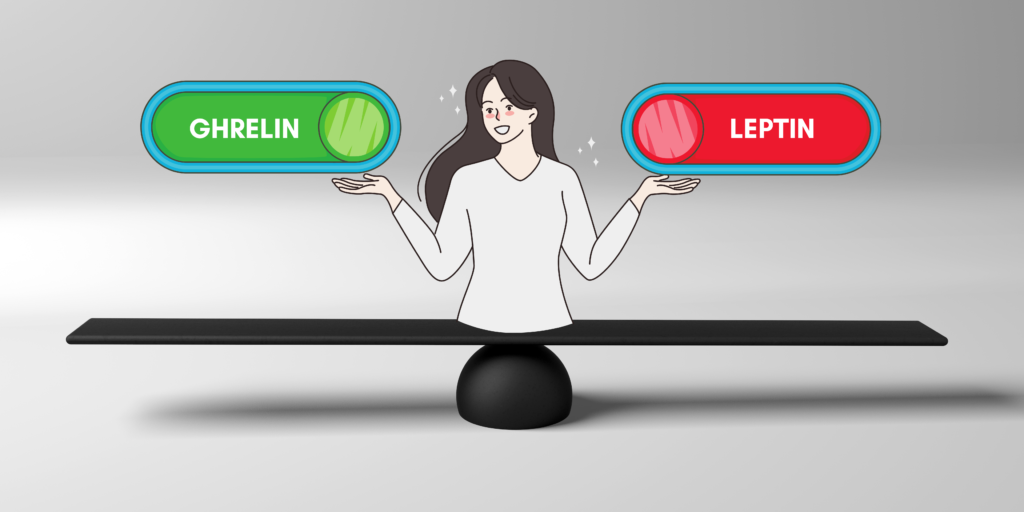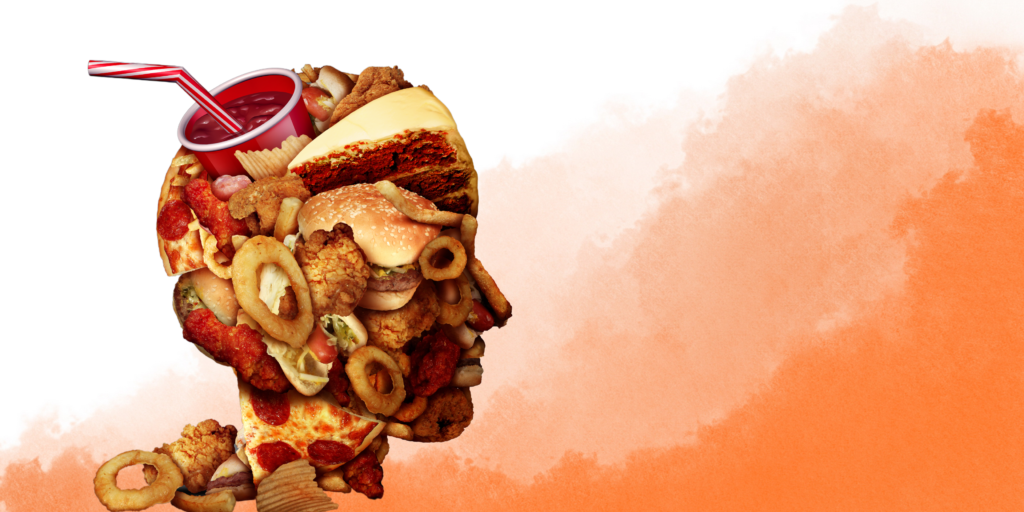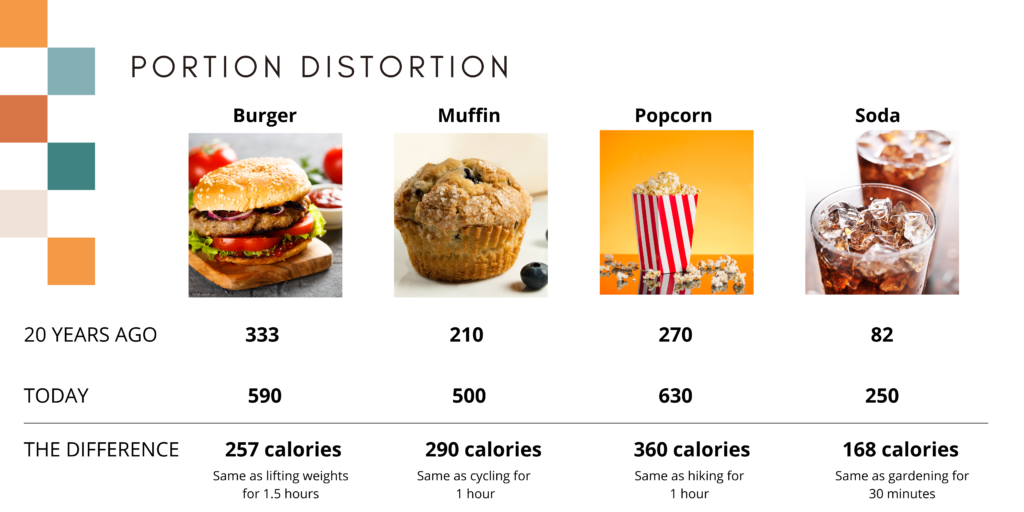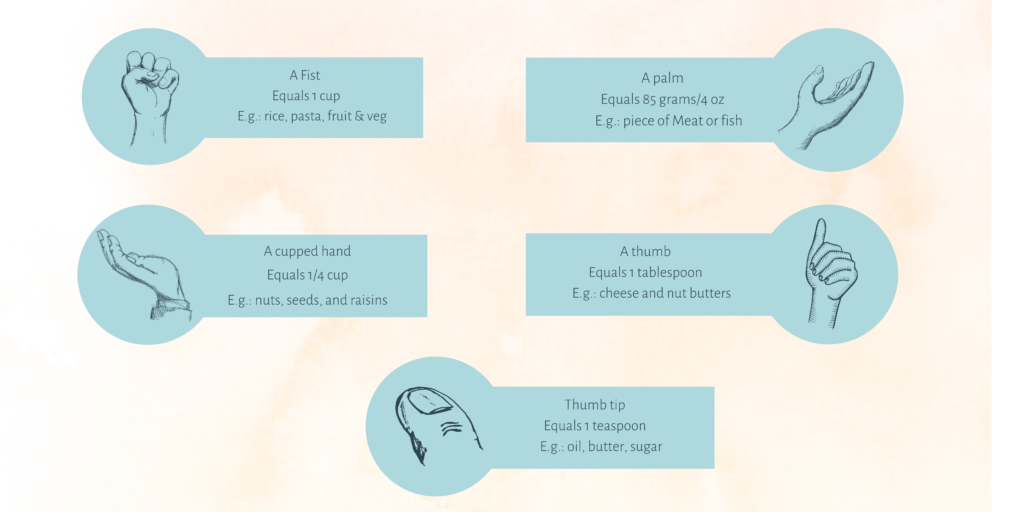Mastering Portion Control – without counting calories!
Explore practical tips, strategies, and insights to help you take charge of your eating habits. Whether you’re aiming to lose weight, improve your energy levels, or simply adopt a healthier lifestyle, understanding portion control is an essential component of reaching your goals.

In a world where super-sized meals and overflowing plates have become the norm, it’s easy to lose sight of what constitutes an appropriate portion. However, the truth is that portion control plays a pivotal role in achieving and maintaining a balanced diet, supporting weight management, and promoting overall well-being.
Once you understand how to manage your portions (along with mindful eating), you’ll be able to adapt your meals wherever you are – and the best part…there’s no need for complicated measuring or tedious calorie counting!
How Your Brain and Hunger Work
Let’s start with how you get hungry in the first place…
Eating is controlled and balanced by a number of hormones in your body that send signals to your brain. When we eat, some hormones work like a bike messenger, delivering messages to our brain to either say
“I’m hungry it’s time to eat” or “Hey, you’ve had enough, stop eating now.”
Your body has an ideal quantity of food that it wants you to eat within a day, so when the brain thinks you need energy, it makes you hungry and more interested in food by releasing hormones that stimulate your appetite.
This is called REAL HUNGER, which means it’s a balanced and necessary hunger for survival.

The main hunger-stimulating hormone is called ghrelin, which when released by the body (mainly by the stomach), tells your brain to go for it and start eating.
As you’re eating the food, sensors in your gut identify protein, carbs and fat, while your stomach also expands. All this information goes back to your brain telling it that there’s a bunch of food in your stomach and you don’t need to eat anymore – you’ve had enough. That’s the short-term balance mechanism.
Once your body is full it releases a hormone called leptin – the appetite-supressing hormone (mainly from your fat cells) –telling your brain that you’ve had enough and it supresses your appetite.
When we eat too fast or just ignore our leptin hormone, another hormone called Peptide Tyrosine steps in as a 2ndmessenger and tells the brain your body feels sick and bloated and now is the time to ‘’really really’’ stop eating.
This is how the body balances eating….in an ideal situation.
What Changes When We Overeat?
Over time, if you eat more than your body needs, it can trigger changes in the brain that can cause a neurochemical dependency, which is just fancy talk for saying that you become addicted to eating.
Another biological change that happens when we over eat occurs with Leptin, the hormone that suppresses our appetite.
Leptin is released from your fat cells. So, the more fat you have, the more leptin your body makes, and the less food you’ll eat. Effectively, the more leptin, the better for weight loss.
You’re probably thinking, ‘’Wait a sec, why don’t these clever scientists just make leptin pills to supress our appetite and voila – problem solved!’’

Unfortunately, biology is complicated and that only works for 5% of the population that is actually leptin deficient. The rest of us are out of luck as we are leptin resistant.
Which means you have enough leptin, your body’s just not responding to it. So, there’s no decrease in your appetite.
Also, if you regularly overeat, your fat cells may produce less leptin to accommodate your preferred eating patterns by allowing your appetite to remain large despite the fact that you’re getting fatter.
Fortunately, this is also reversible by reducing your quantity of food you’re eating.
Why Is our Eating Out of Control?
Our modern lifestyle is no longer a “normal circumstance’’ for our bodies. Our bodies still work on a ‘business-as-usual’ survival system from our caveman days, but our current environment is far from hunter-gatherer.
Our brains are hard-wired from evolution to crave and eat high-calorie foods when available to keep us going through the hard times. The problem is that nowadays the ‘hard times never come’ as calories are ALWAYS available from processed snacks at the grocery store to supersized junk food at the drive-thru. This situation is completely foreign to our brain, and it is overwhelming our body’s natural hungry-full response.
Our brain is set up to reward us when we eat super-rich calorie-dense foods, but this mechanism is more of a hazard than a help in our modern-day lives.

In addition, high calorie processed foods are generally low in fibre, which allow us to eat more calories quickly before our appetite control switch gets activated. It is not unusual for a person to eat a fast-food meal of 1,000 calories in less than 10 minutes – but it takes more than 10 minutes for food to stimulate your brain to say ‘’Hey you’re full, stop eating’’.
Portion Distortion
Not only are calories easier to access, but our portions have become so much larger, meaning we’re eating more calories at every meal.
Even from as little as 20 years ago our food portions have increased and we’re now eating on average over 50% more calories with each and every meal or snack. And it’s so subtle that we don’t even realise it!
In fact, according to a research paper in PLoS Med, over the past 30 years, the average American has increased calories by 570 calories per day. That is a significant amount when it comes to whether we remain at a healthy weight or gain weight. Our diets are putting us at a disadvantage before our brain has time to realize it.
Our plates and glasses have become bigger over the years. Just have a look the next time you’re at a restaurant at the wine glasses and you’ll see they’re now mini fish bowls able to hold half a bottle of wine in one glass.

Adjust Your Plate Size
Humans are visual creatures and our brains will automatically want to fill an empty plate, no matter if that plate is small or large. So why not use a small plate and make it look full (and satisfying) than a large plate and fill it too much or have just enough and the plate looks sparse and unfulfilling.
By using a smaller plate, you’ll dish up less but it will feel like you’re getting more because the plate is full. And keep in mind that you can always go back for more if you are still genuinely hungry. The smaller plate gives your brain an opportunity to catch up and determine if you’re still hungry or full.
Smaller plates will help you with your portion control and weight management.
It’s not just about our plates – you can use this trick on your glassware too.
According to research, a short wide drinking glass will make us over-pour compared with tall slim glass. We can use this to our advantage when making drink decisions. When opting for less healthy drinks like alcohol, juice or soda – go for a tall slim glass as you’re likely to pour less. When it comes to water – opt for a short wide glass.
Top tips for Dishing Up Healthy Portions
Don’t Serve Family-Style
Serve from the kitchen counter or a sideboard rather than putting serving bowls on your dinner table — that way you’ll have to get up for a second helping.
Follow the Half-Plate Rule
Always fill up half your plate with fruits or vegetables. That includes second (or third) helpings!
Resist eating straight from the bag or the box.
Not only is it easier to overeat when you can’t see how much you’ve had, but it is also harder to fully appreciate your food when it is hidden from view
Separate Bulk Snacks Into Small Containers
While it can be cost-saving to buy in bulk, that giant container makes it hard to tell how much you are eating, and to know when to stop. Divide up bulk foods into smaller, individual portions
Use your Hands to Measure
Here’s a quick and easy guide to help you measure a healthy portion:
By using a smaller plate, you’ll dish up less but it will feel like you’re getting more because the plate is full. And keep in mind that you can always go back for more if you are still genuinely hungry. The smaller plate gives your brain an opportunity to catch up and determine if you’re still hungry or full.
Smaller plates will help you with your portion control and weight management.
It’s not just about our plates – you can use this trick on your glassware too.
According to research, a short wide drinking glass will make us over-pour compared with tall slim glass. We can use this to our advantage when making drink decisions. When opting for less healthy drinks like alcohol, juice or soda – go for a tall slim glass as you’re likely to pour less. When it comes to water – opt for a short wide glass.
